利用废物衍生的生物炭集成高速率过滤,作为一种潜在的可持续饮用水供应技术
IF 13.5
2区 环境科学与生态学
Q1 ENVIRONMENTAL SCIENCES
引用次数: 0
摘要
摘要本研究旨在评价桉树(E)和竹(B)生物质残炭作为过滤材料处理饮用水的效率。以120 m3 / m2 /d的速度用水(生水、絮凝水和沉淀水)对这两种生物炭在快速过滤过程中的效率进行了评估。发现慢热解b (Bb)工艺制备的竹生物炭性能最好。随后,用三种不同的粒度法对Bb进行了评价,发现性能最好的有效粒径为最细(0.6 ~ 1.18 mm)。随后,在不同类型的水(原水、絮凝水和沉淀水)和不同过滤速率(120和240 m 3 /m 2 /d)下,将该生物炭与传统滤料如砾石、沙子和无烟煤进行了比较,发现性能最好的滤料正是生物炭,原水的平均去浊率为64.37%,色度为45.08%;絮凝水浊度93.9%,显色90.75%;沉淀水浊度80.79%,显色69.03%。在180 m 3 /m 2 /d的速率下,砂、生物炭、无烟煤和砾石简单床层的铜效率为75.9%,铝效率为90.72%,铁效率为95.7%,硝酸盐效率为10.9%,总大肠菌群效率为94.3%,粪便大肠菌群效率为88.9%。与传统过滤材料相比,生物炭的效率更高。研究还发现,生物炭有助于改善混合床砂和无烟煤的性能。此外,有可能证明,与其他过滤床相比,生物炭所需的洗涤水量较低。最后,建议开展更多试验,利用受采矿和石油开采影响的农村地区的生物炭净化水,以及利用沿海地区干燥森林残留物和城市有机残留物的生物炭净化海水。图形抽象本文章由计算机程序翻译,如有差异,请以英文原文为准。

Integration of high-rate filtration using waste-derived biochar as a potential sustainable technology for drinking water supply
Abstract This research aimed to evaluate the efficiency of eucalyptus (E) and bamboo (B) residual biomass biochars as filter materials for drinking water treatment. The efficiencies of these two biochars in the rapid filtration process were evaluated using water (raw, flocculated and settled) at the rate of 120 m 3 /m 2 /d. Finding that bamboo biochar manufactured under a slow pyrolysis process "b" (Bb) had the best performance. Subsequently, Bb was evaluated with three different granulometries, and it was found that the effective size with the best performance was the finest (0.6–1.18 mm). Subsequently, this biochar was compared with conventional filter materials such as gravel, sand and anthracite, using different types of water (raw, flocculated and settled) and at different filtration rates (120 and 240 m 3 /m 2 /d), and it was found that the filter material with the best performance was precisely biochar, with average removal efficiencies of 64.37% turbidity and 45.08% colour for raw water; 93.9% turbidity and 90.75% colour for flocculated water, and 80.79% turbidity and 69.03% colour for settled water. The efficiency using simple beds of sand, biochar, anthracite and gravel at the rate of 180 m 3 /m 2 /d was 75.9% copper, 90.72% aluminium, 95.7% iron, 10.9% nitrates, 94.3% total coliforms and 88.9% fecal coliforms. The efficiencies achieved by biochar were higher compared to those of conventional filter materials. It was also found that biochar contributes to improving the performance of sand and anthracite in mixed beds. Additionally, it was possible to demonstrate that the volume of washing water required for the biochar is lower compared to the other filter beds. Finally, it is recommended to carry out more tests for the purification of water with biochars from rural areas affected by the mining and oil exploitation, as well as the purification of seawater with biochars from coastal areas with residues from dry forests and organic residues from municipalities. Graphical abstract
求助全文
通过发布文献求助,成功后即可免费获取论文全文。
去求助
来源期刊

Biochar
Multiple-
CiteScore
18.60
自引率
10.20%
发文量
61
期刊介绍:
Biochar stands as a distinguished academic journal delving into multidisciplinary subjects such as agronomy, environmental science, and materials science. Its pages showcase innovative articles spanning the preparation and processing of biochar, exploring its diverse applications, including but not limited to bioenergy production, biochar-based materials for environmental use, soil enhancement, climate change mitigation, contaminated-environment remediation, water purification, new analytical techniques, life cycle assessment, and crucially, rural and regional development. Biochar publishes various article types, including reviews, original research, rapid reports, commentaries, and perspectives, with the overarching goal of reporting significant research achievements, critical reviews fostering a deeper mechanistic understanding of the science, and facilitating academic exchange to drive scientific and technological development.
 求助内容:
求助内容: 应助结果提醒方式:
应助结果提醒方式:


